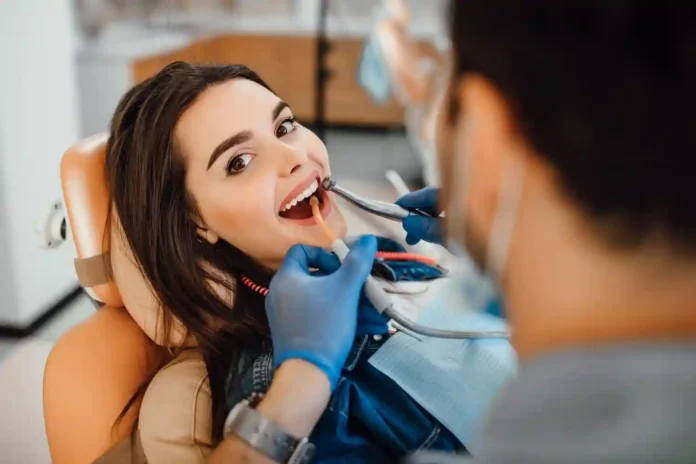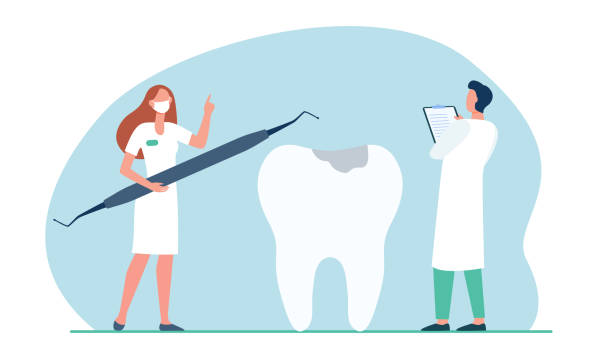Fed up with tartar? Here are 7 tricks my dentist in Deira taught me that actually prevent that gross buildup. No BS, just stuff that works.
So let us first see what exactly tartar is for a hot minute.
I mean, not the sauce – though honestly, that’s way more pleasant to think about than the crusty yellow stuff cementing itself to our teeth like some sort of biological superglue from hell.
Look, I’m not gonna sugarcoat this (pun totally intended). For years, I was that person who’d brush my teeth while mentally planning my outfit for the day, barely paying attention to what I was actually doing. Then I’d show up to my dental cleaning and act all surprised when my hygienist would start going to town with what looked like medieval torture devices.
“Wow, there’s quite a bit of buildup here,” she’d say diplomatically, while I’m thinking, “Lady, just tell me I have tartar and we can both move on with our lives.”
But here’s the kicker – after one particularly brutal cleaning session (we’re talking 45 minutes of scraping that left my mouth feeling like I’d been in a boxing match), I finally asked the real question: “How the hell do I prevent this from happening again?”
Turns out, preventing tartar isn’t some mystical art form that only dental professionals understand. It’s actually pretty doable once you know what you’re doing wrong. And if you’re working with a good dental professional – seriously, finding the best dentist in Deira changed my whole game – they’ll give you the real talk, not just the generic “brush twice daily” speech.
What’s the Deal with Tartar Anyway?
Okay, so here’s what’s actually happening in your mouth (try not to get too grossed out):
Plaque is basically a party for bacteria. They’re hanging out on your teeth, eating the leftover bits of your lunch, and producing acid as a thank-you gift. Charming, right?
Now, if you don’t crash this party daily with your toothbrush, the plaque gets comfortable. Really comfortable. It starts hooking up with minerals in your saliva and – boom – you’ve got tartar. It’s like plaque that’s been hitting the gym and is now too strong for your regular toothbrush to handle.
And once it’s there? Game over. You’re not getting that off with anything in your bathroom cabinet. Trust me, I’ve tried everything from baking soda to those little dental picks (don’t do this at home, kids).
The worst part is that tartar doesn’t just sit there looking ugly. Oh no, it’s actively making your life worse by:
- Making your breath smell like you’ve been french-kissing a garbage disposal
- Irritating your gums until they’re angrier than a cat in a bathtub
- Creating perfect little hideouts for even more bacteria
- Basically, rolling out the red carpet for cavities and gum disease
Fun times, right?
7 Dentist-Backed Hacks to Prevent Tartar Build-up
Hack #1: Actually Brush for Two Minutes (I Know, Revolutionary)
Let me guess – you’re one of those people who does the quick-brush-and-dash routine? Yeah, me too. Until I realized I was basically just moving toothpaste around my mouth like I was finger painting.
Real talk: two minutes feels like FOREVER when you’re actually doing it properly. I started using my phone timer, and holy crap, those first few times felt like watching paint dry.
Here’s how to not hate those two minutes:
Set up camp in front of the TV or mirror and make it entertaining. I literally watch TikToks while brushing now (don’t judge).
The magic formula that actually works:
- 30 seconds on each quadrant of your mouth
- Use small circular motions, not the back-and-forth scrubbing that makes you look like you’re trying to start a fire
- Tilt your brush toward your gums at about 45 degrees (yeah, angle matters – who knew?)
Also, can we talk about electric toothbrushes for a sec? I was skeptical for years because they seemed like an overpriced gadget. But damn, they work. The vibration breaks up plaque way better than my sad manual scrubbing ever did.
My dentist told me something that blew my mind: most people only clean about 60% of their tooth surfaces when brushing manually. With an electric brush and proper technique, you can get up to 90%. That’s a game-changer for tartar prevention.
Hack #2: The Toothpaste Situation (Plot Twist: Brand Matters)
Not gonna lie, I used to just grab whatever toothpaste was on sale. Crest, Colgate, that weird natural stuff that tastes like sadness – didn’t matter to me.
Turns out, I was an idiot.
Tartar control toothpaste is actually different. It has these things called pyrophosphates that literally prevent the minerals from sticking together to form tartar. It’s like having a bouncer for your mouth.
But here’s the trick nobody tells you: don’t rinse immediately after brushing. I know, I know, it feels weird. But that fluoride needs time to do its job. Spit out the excess foam, sure, but let that good stuff sit on your teeth for at least 30 minutes.
I switched to a tartar control formula with fluoride about six months ago, and the difference at my last cleaning was honestly shocking. My hygienist was like, “What did you change?” Because apparently, I went from tartar city to… well, significantly less tartar city.
Pro tip: If you’re dealing with heavy buildup, ask your dentist about prescription toothpaste. It’s stronger than the over-the-counter stuff and can make a real difference.
Hack #3: Flossing (But Let’s Be Real About It)
Okay, let’s have an honest conversation about flossing. We all know we should do it. Most of us don’t. And when we do, we’re probably doing it wrong.
I was definitely in the “floss the night before my dental appointment” camp for way too long. Don’t be me.
Here’s what actually works in real life:
Traditional string floss is great if you’ll use it. But if you’re like me and find it annoying, get a water flosser. Yeah, they look weird and sound like a tiny pressure washer, but they’re amazing.
I got one for my birthday last year (thanks, sister who obviously thinks my oral hygiene needs work), and it’s honestly kind of addictive. There’s something weirdly satisfying about blasting all the junk out from between your teeth.
Other options that don’t suck:
- Floss picks (not as good as traditional floss, but infinitely better than no floss)
- Interdental brushes (like tiny bottle brushes for your teeth – great for bigger gaps)
- Those floss holder things, if you have dexterity issues
The real secret: Floss BEFORE brushing, not after. It loosens everything up so your toothbrush can actually reach the good stuff.
And if your gums bleed a little at first? Don’t panic. That usually means you haven’t been cleaning those areas well, and it should stop once you get into a routine.
Hack #4: Mouthwash That Actually Does Something
I used to think mouthwash was just liquid breath mints. Swish, spit, smell minty fresh, done.
Wrong again.
The right mouthwash is like having backup dancers for your toothbrush and floss. It gets into all the tiny spaces they might miss and keeps working after you’re done.
But – and this is important – timing matters. Don’t use it right after brushing because you’ll wash away all that good fluoride you just applied. Use it at a different time, like after lunch or before bed, if you brush in the morning.
Look for antibacterial formulas with ingredients you can’t pronounce (kidding, but seriously, cetylpyridinium chloride is your friend). These actually kill the bacteria that cause plaque, rather than just making your mouth taste like Christmas.
My routine now: Brush and floss at night, then use antibacterial mouthwash after lunch the next day. It’s like having a mid-day reset button for my mouth.
Hack #5: Food Choices (Without Being a Total Buzzkill)
I’m not gonna sit here and tell you to never eat sugar again, because let’s be realistic – that’s not happening. But there are some surprisingly easy changes you can make that actually help.
Stuff that fights tartar (seriously):
- Cheese (it neutralizes acid and gives your teeth calcium – basically a superfood for your mouth)
- Crunchy vegetables like celery and carrots (nature’s toothbrush)
- Green tea instead of coffee sometimes (contains compounds that fight bacteria)
- Strawberries (the malic acid helps break down plaque – who knew?)
Stuff that feeds the tartar monsters:
- Sticky candy (obvious, but worth mentioning)
- Crackers and chips (these stick to your teeth like cement)
- Dried fruit (nature’s candy, but still candy)
- Soda (the acid plus sugar is basically a tartar rave)
The real game-changer: Drink more water. Like, a lot more water. It washes away food particles and keeps your saliva production up, which is your mouth’s natural cleaning system.
I started carrying a water bottle everywhere and noticed my mouth felt cleaner throughout the day. Plus, staying hydrated is good for literally everything else, too, so win-win.
Hack #6: Don’t Skip Your Cleanings (Even When They’re Expensive/Scary/Inconvenient)
Look, I get it. Dental cleanings aren’t exactly fun, and they’re not cheap. For years, I’d put them off until my teeth felt fuzzy or my breath could kill a plant.
But here’s the thing: professional cleanings aren’t just about fixing problems. They’re actually one of the best ways to prevent tartar in the first place.
Why cleanings are worth it:
- They remove tartar that’s already formed (only they can do this)
- They polish your teeth, so plaque has a harder time sticking
- They catch problems before they become expensive problems
- Your hygienist can show you exactly where you’re missing spots
Pro tip: Ask questions during your cleaning. “Where am I missing plaque?” “What should I be doing differently?” Most hygienists love talking about this stuff, and you’ll learn way more than from any blog post (even this one).
If you’re dealing with heavy tartar buildup, ask about more frequent cleanings. Yeah, it’s more money upfront, but it’s way cheaper than dealing with gum disease or cavities later.
And seriously, if you’re in the area, working with the best dentist in Deira means getting personalized advice that actually fits your lifestyle and specific mouth situation.
Hack #7: Consistency (The Unsexy Truth)
Here’s where I’m gonna get real with you: none of this matters if you only do it when you remember, or when you’re feeling motivated, or when Mercury isn’t in retrograde.
Tartar prevention is boring. It’s not Instagram-worthy or exciting. It’s just… showing up every day and doing the work.
I know that’s not what you want to hear. Trust me, I wanted there to be some magic trick or secret hack that would let me be lazy and still have perfect teeth. Spoiler alert: there isn’t.
What actually works:
- Pick one or two changes and focus on those first
- Don’t try to overhaul your entire routine overnight
- Make it as easy as possible (keep floss picks in your car, set phone reminders, whatever)
- Track your progress somehow – even just marking an X on a calendar
My personal hack: I linked my new habits to stuff I was already doing. Floss while waiting for my coffee to brew. Mouthwash after I put on moisturizer. Water flosser while watching Netflix.
The key is making it automatic, not something you have to think about or talk yourself into every day.
Your Tartar-Fighting Arsenal: Ready to Deploy
Alright, let’s wrap this up. Preventing tartar isn’t rocket science, but it’s not exactly intuitive either. Most of us learned to brush our teeth when we were five and never got an update on the technique.
Start here:
- Get serious about your two-minute brushing routine
- Switch to a tartar control toothpaste and stop rinsing immediately after
- Find a flossing method you’ll actually use and do it consistently
- Add antibacterial mouthwash at a different time than brushing
Level up with:
- Smarter food and drink choices
- Regular professional cleanings
- Staying hydrated like your oral health depends on it (because it does)
Remember, every mouth is different. What works for your coworker or that person on Instagram might not work for you. Don’t be afraid to experiment until you find your perfect routine.
The bottom line: Future you will thank present you for figuring this out now. Trust me, sitting through a 45-minute tartar removal session is way worse than spending an extra few minutes on your oral care routine each day.
Ready to get serious about your oral health? Start with the basics, be consistent, and don’t be afraid to ask your dental team for help. They want you to succeed at this stuff – it makes their job easier, too.
Your teeth (and your wallet) will thank you.
FAQ: The Stuff You’re Actually Wondering
Q: Okay, but seriously, how fast does plaque turn into tartar? A: Faster than you think – we’re talking 24 to 72 hours. That’s why skipping even a day or two of proper cleaning can set you back. It’s like letting dishes pile up in the sink, except grosser.
Q: Can I scrape tartar off myself? I saw this thing on YouTube… A: Please don’t. I know it’s tempting, especially when you can feel it with your tongue, but you can seriously damage your teeth and gums. Plus, you probably won’t get it all anyway, so you’re just wasting time and risking injury.
Q: Are those expensive electric toothbrushes actually worth it? A: Short answer: yes. Long answer: they’re way better at removing plaque than manual brushing, especially if you’re lazy about technique (like most of us). You don’t need the fanciest one – even a basic electric brush will outperform manual brushing.
Q: My dentist wants me to come in every 3 months instead of 6. Is that overkill? A: Probably not, especially if you’ve had tartar problems before. Some people just build it up faster due to genetics, saliva composition, or other factors. It’s cheaper than dealing with bigger problems later, trust me.
Q: Will oil pulling or other “natural” methods work instead of regular brushing? A: Look, I’m all for natural approaches, but oil pulling isn’t a replacement for mechanical plaque removal. It might help with bacteria, but it’s not getting that sticky plaque off your teeth. Use it as an addition, not a replacement.



































